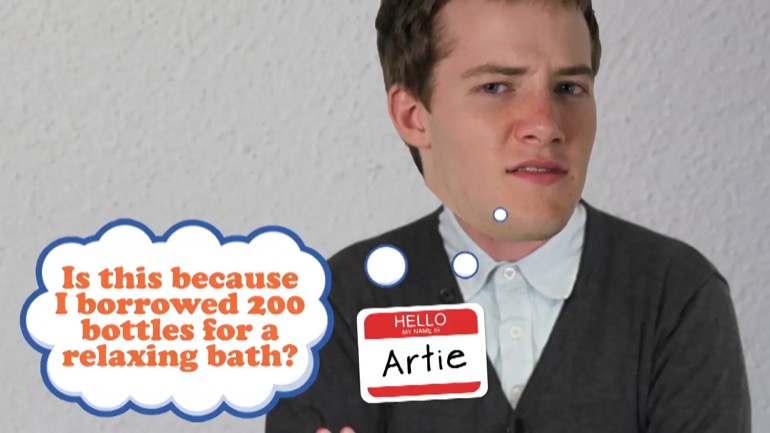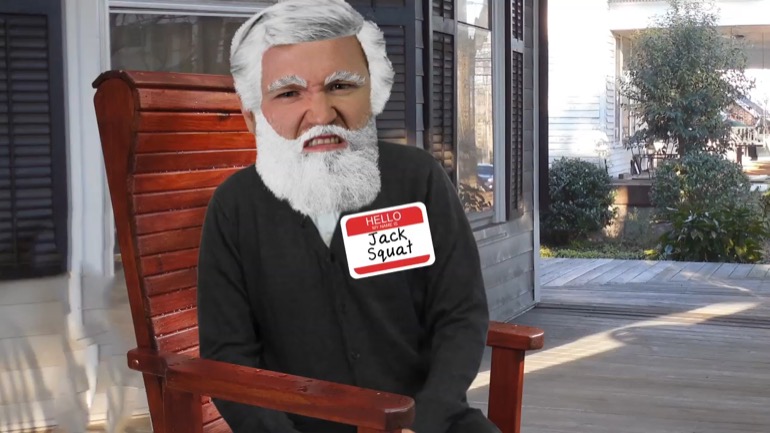ShmoopTube
Where Monty Python meets your 10th grade teacher.
Search Thousands of Shmoop Videos
Principles of Finance Videos 166 videos
How is a company... born? Can it be performed via C-section? Is there a midwife present? Do its parents get in a fight over what to name it? In thi...
Company Formation, Structure, and Inception: Unit Intro. Sorry, Leo DiCaprio fans—we're not going to be breaking down the plot of Inception. We'r...
Okay, so you want to be a company financial manager. It's basically up to you to make money for the shareholders. It would also be swell if you mad...
Principles of Finance: Unit 5, Bond Maturity and Zero Coupon Bonds 11 Views
Share It!
Description:
What are bond maturity and zero coupon bonds, and how are they related? Or are they NOT related, and this is just a very weird video?
Transcript
- 00:00
Principles of finance a la shmoop bond maturity and zero coupon bonds well [Briefcase with bond maturity and zero coupon bonds on the front]
- 00:07
unlike the writers at shmoop bonds eventually mature what does that mean
- 00:12
well yes in fact bonds get hair on their private parts and become distinctively [Bond grows hair]
- 00:16
attractive to other bonds and well there's a rebellion against their issuer
- 00:21
that's only natural okay so bond maturity let's frame a
Full Transcript
- 00:24
couple of things here first a bond is issued or sold it has a nominal rate ie
- 00:29
the amount it will pay in interest for renting the principal you know from
- 00:34
investors it has a duration or rather a time period that'll pass before the bond [Duration circled on a bond]
- 00:39
fully matures and the principal owed is returned and the bond might have other
- 00:42
features like put in call provisions which would entitle owners of the bond
- 00:46
to force the company or issue or to buy the bonds back usually at a discount or
- 00:50
call provisions which would allow the issuer of the bonds to buy them back
- 00:54
usually at a modest premium to the par value at which they were issued there's
- 00:57
also a PIK provision where they can pay in kind ie pay the interest of cash in [PIK provision definition on a whiteboard]
- 01:02
stock instead so think about the cash flows on a twenty-five thousand dollar
- 01:06
bond with a coupon of eight percent maturing in ten years well here's what
- 01:10
the cash flows look like mmm, what happened? well financially this is what
- 01:15
happens you get minus twenty five thousand and minus because the amount
- 01:18
was subtracted from your Wells Fargo checking account when it was deposited [Well Fargo logo with stack of cash]
- 01:22
into the coffers of the Comcast corporation when he bought the bond that
- 01:26
was part of their new bond offering to fund something that will save cable from
- 01:30
free Wi-Fi wimax well twice a year you get a plus one
- 01:34
thousand bucks that is an eight percent coupon pays two grand a year on a
- 01:38
twenty-five thousand dollar bond but again just to bludgeon you over the head
- 01:42
with this concept bonds normally pay twice a year so you'd get a grand twice
- 01:46
a year for ten years that's twenty payments of a grand and your last
- 01:50
payment would be for what... yes twenty six thousand dollars because you'd collect
- 01:56
your last coupon payment of that thousand dollars and then you get your [Payments of bonds listed]
- 01:59
principal back easy-peasy vanilla so that's standard maturity of a bond, but
- 02:04
there are other ways bonds mature as well so next type of maturity is a balloon
- 02:08
maturity and yes you can tell we're still working on [Clown making balloons and shmoop workers laugh]
- 02:13
In a balloon maturity the
- 02:14
principle is generally retired in nuggets maybe 5% is repaid after two [Balloon maturity explanation on whiteboard]
- 02:18
years and then another 12 and 1/2 percent of the bond that was issued
- 02:22
retired after three years and then 25% after seven years in Tibet so that the
- 02:27
principal shrinks in stages to nothing that is it's balloons of debt pop over [Debt balloons expand and pop]
- 02:32
time...but with big chunks paid off like a step function rather than the slow
- 02:37
gradual pay down of something like a typical home mortgage where a tiny bit
- 02:42
of principal is paid down each month until on the final month's payment most
- 02:46
of that payment is in fact principal think of it as serial liposuction of
- 02:50
debt all right next up zero coupon bonds, and yep your hunch is right zero coupon
- 02:56
bonds are bonds with no coupon... well they don't pay cash
- 03:00
interest along the way why would anybody want a bond that pays no coupon and no
- 03:05
interest well no in fact the bond does pay interest it just pays all of the
- 03:09
interest at the very end of the duration when the bond finally matures ie it has
- 03:16
outgrown shmoop writing stables here and the principal
- 03:19
plus all of the accrued interest payments are then paid all at once
- 03:22
well these type of bonds are sold at a discount to par with investors simply [Bond maturity breakdown]
- 03:27
collecting the par value so many years later in one lump sum...US government
- 03:32
short term paper trades this way and in the case of US government paper there's
- 03:36
no stated interest rate the bonds just traded a discount to par in an auction
- 03:45
okay so here's the sitch you have a bond being offered at $1,000 par value it's [Man discussing bond at $1,000 par value]
- 03:50
being sold today for 700 bucks which is a discount to par of $300 what's the
- 03:55
yield of this zero coupon bond
- 04:02
...okay trick question this one's impossible to answer why
- 04:07
because we didn't give you the duration without it you have no idea if you get
- 04:12
your thousand dollar principle and interest in one year or 10 years or a [Duration of bond changes from 1 year to 10 years]
- 04:16
hundred years or when the cows come home like when did they ever leave anyway all
- 04:20
right well so if you buy that zero coupon bond for $700 when it comes to
- 04:23
you in say six years you'll agglomerate the interest and the gradual increase in
- 04:27
principal when you calculate the value of the bond going forward while [Calculations of the bond through 6 years]
- 04:31
calculating the yields on zeros is a bit gnarly the basic idea here is just that [Surgeons performing operation]
- 04:36
you get nothing back until the end when you get it all back but by way of
- 04:42
example if you borrowed a thousand dollars for six years at 12% rate of
- 04:46
interest well you would get nothing along the way in roughly two thousand
- 04:50
dollars at the end in one lump sum payment remember that rule of 72 thing [Rule of 72 appears on the board]
- 04:54
here's the handy dandy way of calculating all that got it okay in this
- 04:57
case what are the risk characteristics of a bond like this, riskier or less
- 05:02
risky than a vanilla bond answer: riskier why well because the investors get
- 05:06
nothing along the way so all bets are on that investors get fully paid way at the [Rainbow appears]
- 05:12
end of the rainbow there's also a risk that the company doesn't sock away
- 05:15
enough money to pay off these zeros at the end or that they have a hard time
- 05:19
refinancing them at the very end if they haven't been disciplined enough to save [Woman worried about saving cash]
- 05:22
cash along the way or if their businesses you know gone to the crapper
- 05:26
there with no direct obligation to put away a few nuts each month for this [Squirrel eating nuts in the field]
- 05:29
eventual big fat payout it's easy for companies to get kind of sort of you
- 05:34
know forgetful about them well to stem some fears most corporations create
- 05:38
what's called a sinking fund an amount of money that they sink into a piggy
- 05:42
bank for the day that the debt money comes due not surprisingly zeros usually
- 05:47
pay higher yield or higher interest rates and carry these higher yields
- 05:51
because of this illiquidity feature like you don't get any cash
- 05:55
long time it's a bummer not to get at least a little cash along the way and [$1,000 bond with no interest for each year]
- 05:59
it's also a bummer to have to carry all that risk for an eventual payout way
- 06:02
down the line so that's why they have to pay you more in interest to rent your
- 06:06
money all right to the lesson well no matter how many comics you might own or [Series of comic books]
- 06:09
if you know farty jokes you might laugh at well you always have a shot at
- 06:13
maturity as long as you own a bond [Man discussing maturity in bonds]
Related Videos
GED Social Studies 1.1 Civics and Government
What is bankruptcy? Deadbeats who can't pay their bills declare bankruptcy. Either they borrowed too much money, or the business fell apart. They t...
What's a dividend? At will, the board of directors can pay a dividend on common stock. Usually, that payout is some percentage less than 100 of ear...
How are risk and reward related? Take more risk, expect more reward. A lottery ticket might be worth a billion dollars, but if the odds are one in...







































































































